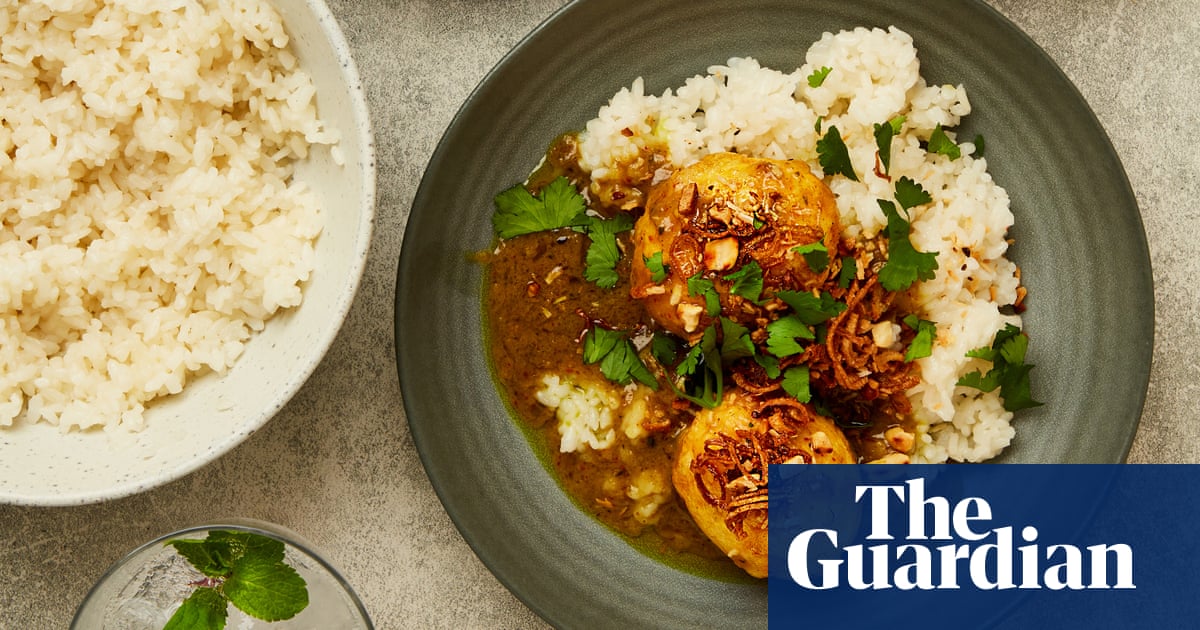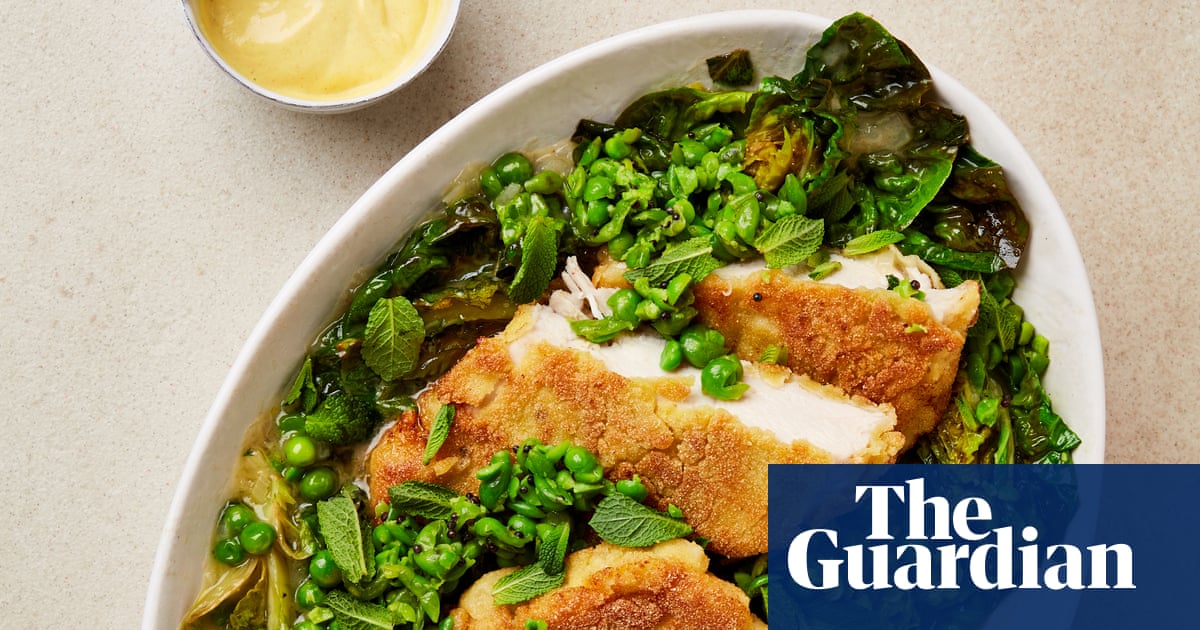
Thai New Year, or Songkran, is celebrated next weekend. Traditionally, water symbolises happiness and purity across the kingdom, and the festivities culminate in a huge nationwide water fight. If there’s an end-of-festival tradition more delightfully fun than this, I’m not sure what it is. I’d love to be in Thailand myself one year, water pistol in tow, but for now, I’ll be in the kitchen having almost as much fun. I’ll also certainly be staying dry while paying homage to the end of one year and the start of the next.
Son-in-law eggs (kai loug kheuh – pictured above)
Stories abound as to how this dish got its name. Some think these golden eggs symbolise the wealth that parents want in a future son-in-law, while others home in on how similar they look to various parts of the male anatomy. Either (or neither) way, this is a quite brilliant dish. The paste, sauce and coconut crunch can all be made well in advance. These quantities will make more of both the paste and sauce than you need here, but they both freeze well and are wonderful tossed through noodles and a few stir-fried vegetables. Serve with jasmine or Thai sticky rice.
Prep 20 min
Cook 45 min
Serves 4
8 eggs
For the coconut crunch
2 tbsp desiccated coconut
2 tbsp roasted unsalted peanuts, lightly crushed
200ml vegetable oil
½ shallot, thinly sliced into half-moons (50g), or 2 tbsp shop-bought crispy shallots
For the curry paste
4cm piece fresh root ginger, peeled and roughly chopped
2 garlic cloves, peeled and roughly chopped
½ shallot, roughly chopped (50g)
10-12 fresh makrut lime leaves (6g), large stems removed
1 lemongrass stalk, woody green top chopped off and discarded, the rest roughly chopped (10g)
10g soft coriander stems, roughly chopped, plus 5g coriander leaves, roughly chopped, for serving
1 tsp coriander seeds
½ tsp ground turmeric
2 dried red chillies, or 1 tsp chilli flakes
1 fresh green chilli (bird’s eye if you like it spicy)
2 tbsp tamarind paste
2 tbsp vegetable oil
For the curry sauce
400ml tinned coconut milk
1 cinnamon stick
2 tbsp curry paste (see above and method)
1 tbsp fish sauce
1½ tsp palm sugar, or dark brown sugar
1 tbsp lime juice
To serve
Cooked jasmine or Thai sticky rice
Half-fill a medium saucepan with water and bring it to a boil. Gently submerge the eight eggs in the boiling water and cook for six and a half minutes exactly, then drain and put under cold running water for a few minutes to cool. Peel the eggs and put on a plate lined with kitchen paper to dry out.
Toast the desiccated coconut in a medium nonstick saute pan on a medium-low heat for two to three minutes, stirring occasionally, until just turning light brown. Add the peanuts, toast, stirring occasionally, until everything is a deep golden brown, then tip into a bowl.
If you’re not using shop-bought crispy shallots, put the vegetable oil in a small pan, drop in the sliced shallots and fry gently, stirring often, on a medium-low heat for about 20 minutes, until light brown. Use a slotted spoon to lift the shallots on to a second plate lined with kitchen paper and leave to drain; save the oil for later. Once the fried shallots are dry, mix them with the coconut and peanuts.
Now for the curry paste. Put all the ingredients in a blender and blitz smooth; if need be, add a few tablespoons of cold water to help it along.
Put 130ml coconut milk and the cinnamon stick in a medium frying pan on a medium-high heat, then cook for two minutes, until the coconut milk thickens and the oil starts to separate. Add two tablespoons of the curry paste, cook for two minutes more, then stir in the fish sauce and palm sugar and fry for another three minutes. Tip in the rest of the coconut milk, then simmer on a medium heat for about eight minutes, until the sauce has reduced by half and thickened sufficiently to coat the back of a spoon. Take off the heat, stir in the lime juice and put somewhere warm while you get on with the eggs.
Put the shallot oil pan back on a medium-high heat and, when it’s hot and shimmering and almost beginning to smoke, gently lower in the peeled eggs – be careful, because they will spit. Fry for three to four minutes, turning the eggs regularly so they cook evenly – the egg whites will blister, wrinkle and turn golden brown – then scoop out on to another plate lined with kitchen paper.
Put the fried boiled eggs in a wide, shallow serving bowl, spoon over two-thirds of the curry sauce, sprinkle on half the coconut crunch and serve at once with the rest of the crunch and rice alongside.
Classic retested: Thai ‘fried’ chicken with coconut sambal
When I first made this dish back in 2014, I par-cooked the chicken in the oven, then deep-fried it to finish, but on reflection, and after making it again recently, I have to say I now prefer to do all the cooking in the oven, so it’s not really fried any more. Start a day ahead, so the chicken has time to take on the flavours of the marinade. To save myself a battle with a whole fresh coconut, I often use the prepared fresh coconut flesh you can buy in some supermarkets.
Prep 30 min
Marinate Overnight
Cook 1 hr
Serves 4
8 skin-on chicken legs (ie thighs and drumsticks)
1 lime, cut into wedges, to serve
For the marinade
4 medium-sized lemongrass stalks, outer leaves discarded, soft inner part finely sliced
1 large garlic clove, peeled and roughly chopped
25g palm sugar, or dark brown sugar
30g coriander (soft stalks and leaves), roughly chopped
2 medium green chillies, roughly chopped
6 fresh makrut lime leaves, stems pulled off and discarded, leaves finely chopped (or 10g dried makrut lime leaves)
2 tbsp coconut cream
1 shallot, peeled and roughly chopped
50g fresh root ginger, peeled and roughly chopped
2 tbsp lime juice
1 tbsp sunflower oil
1 tsp flaked sea salt
1 tsp fish sauce
For the sambal
25g palm sugar, crumbled, or dark brown sugar
2 green chillies, pith and seeds removed, flesh finely sliced into half-moons
100g fresh coconut, finely grated
2 small shallots, peeled and finely sliced
2 tbsp lime juice
1 tbsp sunflower oil
1 tsp fish sauce
A day ahead, put all the marinade ingredients in the small bowl of a food processor and blitz to a rough paste. Put a third of the paste in a small bowl or container, cover and refrigerate. Lightly score each chicken leg three or four times with a sharp knife, then put them in a large bowl, spoon over the remaining marinade and rub it in with your hands. Cover and refrigerate overnight.
Take the chicken out of the fridge an hour or so before you want to cook it, so it comes back to room temperature. Heat the oven to 230C (210C fan)/450F/gas 8, and line a large baking tray with greaseproof paper. Scrape the excess marinade off the chicken and discard, then put the legs on the tray and roast for 20 minutes. Turn down the oven to 180C (160C fan)/350F/gas 4 and roast for another 30 minutes.
Meanwhile, mix all the sambal ingredients in a small bowl. Take the chicken tray out of the oven and leave it to rest for five minutes. Spread the reserved marinade over each leg, top with the sambal and serve with the lime wedges for squeezing over.












